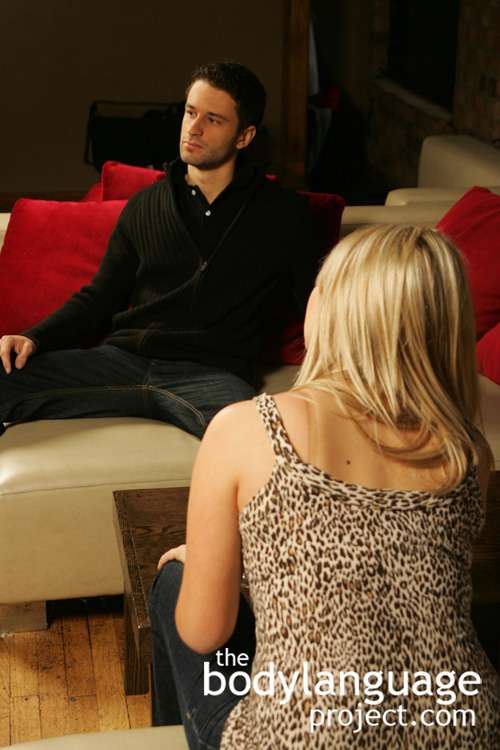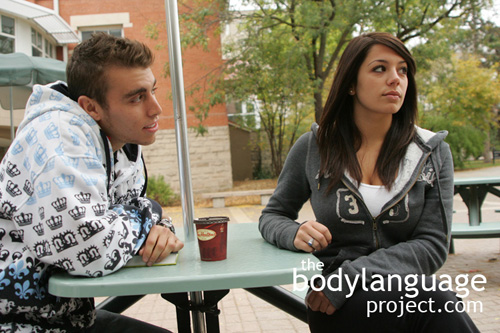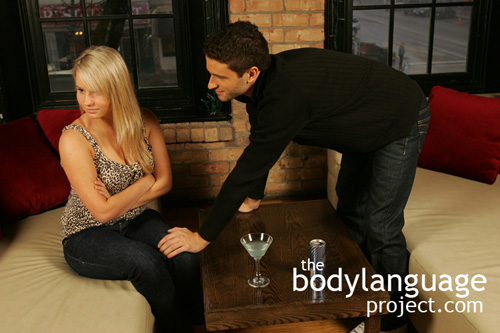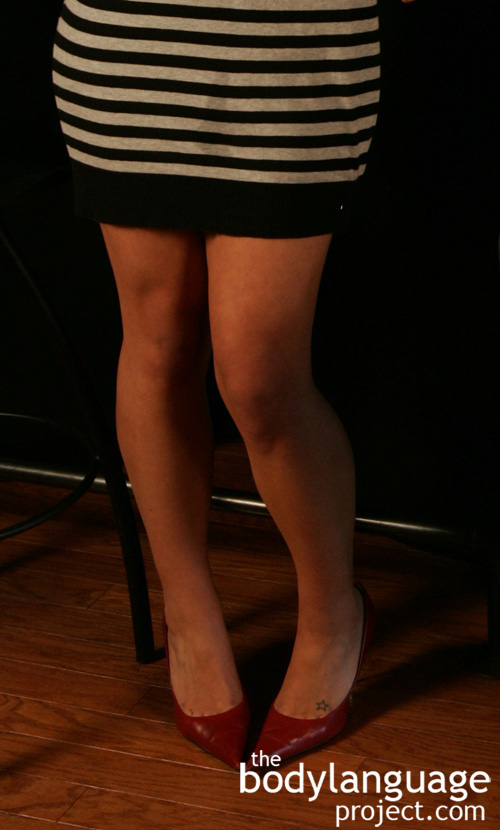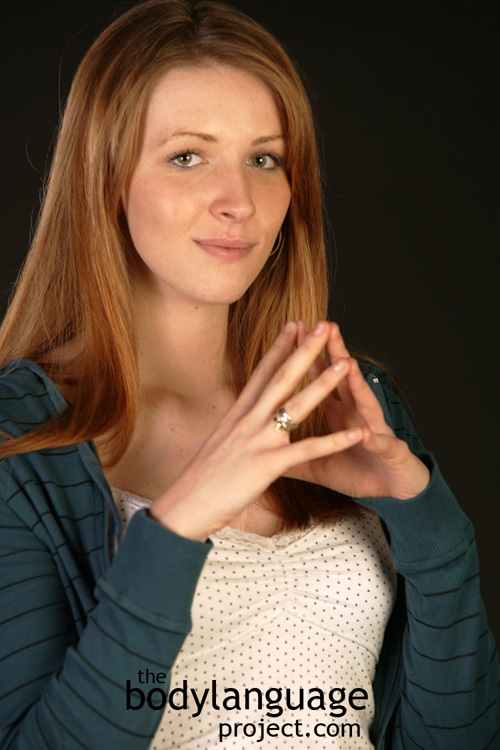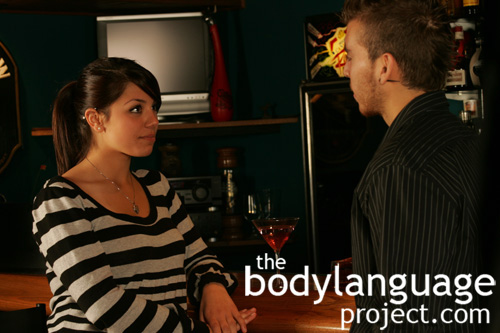Body Language of Leg Spreading
Synonym(s): Spreading The Legs, Open Legs, Leg Placed Over The Arm Of The Chair, Uncrossed Legs.
Description: Legs that are spread while seated or standing rather than crossed.
In One Sentence: Leg spreading is a sign of dominance as it puts the genitals on display.
How To Use it: Spread your legs when you want others to see you as dominant and authoritative. The posture serves both women and men in the same fashion, but men are afforded more social liberty when it comes to dominance displays.
Men can benefit most from this posture in business and in dating as dominance is a valued trait in these context. Women should resist the urge to display dominance in this fashion, but if they absolutely feel comfortable displaying this way, they must wear long pants. Opening the legs with feminine attire including skirts and dresses, or even shorts can give the impression of sexual easiness and will have quite the opposite connotation to that desired.
Resources:
Allen, Jill; Sarah J. Gervais and Jessi L. Smith. Sit Big to Eat Big: The Interaction of Body Posture and Body Concern on Restrained Eating. Psychology of Women Quarterly 2013. 37(3): 325-336. DOI: 10.1177/0361684313476477pwq.sagepub.com
http://bodylanguageproject.com/articles/sit-big-to-eat-big-how-constrictive-postures-reduce-food-consumption/
Arnette, S. L., & Pettijohn, T. F., II. (2012). The effects of posture on self-perceived leadership. International Journal of Business and Social Science, 3, 8–13.
Bohns, Vanessa K. and Scott S. Wiltermuth. It Hurts When I Do This (Or You Do That): Posture And Pain tolerance. Journal of Experimental Social Psychology. 2012. 48: 341-345.
http://bodylanguageproject.com/articles/dominant-and-submissive-postures-affects-more-than-public-perception-it-also-affects-felt-pain-and-physical-strength/
Briñol, P., Petty, R. E., & Wagner, B. (2009). Body posture effects on self-evaluation: A self-validation approach. European Journal of Social Psychology, 39, 1053–1064.
Bartholomewn, Morgan E.; Sheri L. Johnson. Nonverbal Dominance Behavior Among Individuals at Risk for Mania. Journal of Affective Disorders. 2014. 159: 133-138.
Burgoon, J. K., Johnson, M. L., & Koch, P. T. (1998). The nature and measurement of interpersonal dominance. Communication Monographs, 65, 308–335.
Carney, Dana R.; Amy J.C. Cuddy; Andy J. Yap. Power Posing: Brief Nonverbal Displays Affect Neuroendocrine Levels and Risk Tolerance. Psychological Science, 2010; 21 (10): 1363-1368.
http://bodylanguageproject.com/articles/benefits-power-posing-high-stakes-performance/
Cesario, J., & McDonald, M. M. (2013). Bodies in context: Power poses as a computation of action possibility. Social Cognition, 31, 260–274.
Cuddy, Amy J.C., Caroline A. Wilmuth, and Dana R. Carney. The Benefit of Power Posing Before a High-Stakes Social Evaluation. Harvard Business School Working Paper, No. 13-027, September 2012.
http://bodylanguageproject.com/articles/benefits-power-posing-high-stakes-performance/
Carney, D. R., Hall, J. A., & LeBeau, L. S. (2005). Beliefs about the nonverbal expression of social power. Journal of Nonverbal Behavior, 29, 105–123.
Cuddy, Amy J.C., Caroline A. Wilmuth, and Dana R. Carney. The Benefit of Power Posing Before a High-Stakes Social Evaluation. Harvard Business School Working Paper, No. 13-027, September 2012.
http://bodylanguageproject.com/articles/benefits-power-posing-high-stakes-performance/
Cashdan, Elizabeth. Smiles, Speech, and Body Posture: How Women and Men Display Sociometric Status and Power. Journal of Nonverbal Behavior. 1998. 22(4): 209-228.
de Lemus, Soledad; Russell Spears and and Miguel Moya. The Power of a Smile to Move You: Complementary Submissiveness in Women’s Posture as a Function of Gender Salience and Facial Expression. Personality and Social Psychology Bulletin. 2012. 38(11): 1480-1494.
Fischer, Julia; Peter Fischer; Birte Englich; Nilüfer Aydin and Dieter Frey. Empower My Decisions: The Effects of Power Gestures on Confirmatory Information Processing. Journal of Experimental Social Psychology. 2011. 47: 1146-1154.
http://bodylanguageproject.com/articles/downside-power-posing-body-language-looking-power-posing-action-study/
Gorkan Ahmetoglu, Viren Swami. Do Women Prefer “Nice Guys?” The Effect Of Male Dominance Behavior On Women’s Ratings. Social Behavior And Personality, 2012; 40(4), 667-672.
http://bodylanguageproject.com/articles/how-to-significantly-increase-male-attractiveness-with-simple-body-language-nice-guys-finish-last-once-again/
Gregersen, Tammy S. Nonverbal Cues: Clues to the Detection of Foreign Language Anxiety. Foreign Language Annals. 2005. 38(3): 388-400
http://bodylanguageproject.com/articles/what-anxious-learners-can-tell-us-about-anxious-body-language-how-to-read-nonverbal-behavior/
Huang, L., Galinsky, A. D., Gruenfeld, D. H., & Guillory, L. E. (2011). Powerful postures versus powerful roles: Which is the proximate correlate of thought and behavior? Psychological Science, 22, 95–102.
Jacob, Heike ; Kreifelts, Benjamin ; Brück, Carolin ; Erb, Michael ; Hösl, Franziska ; Wildgruber, Dirk. Cerebral integration of verbal and nonverbal emotional cues: Impact of individual nonverbal dominance. NeuroImage. 2012. 61(3): 738-747.
Lee Ann Renninger, T. Joel Wade, Karl Grammer. Getting that female glance: Patterns and consequences of male nonverbal behavior in courtship contexts. Evolution and Human Behavior. 2004; 25: 416–431.
http://bodylanguageproject.com/articles/part-i-how-to-read-male-sexual-body-language-a-study-for-women-and-the-men-who-wish-to-cheat-the-system/
Locke, Connson C. and Cameron Anderson. The Downside of Looking Like a Leader: Leader’s Powerful Demeanor Stifles Follower Voice in Participative Decision-Making.. Academy of Management Annual Meeting Proceedings. 2010. 8(1): 1-6.
http://bodylanguageproject.com/articles/power-body-language-goes-far/
Laird, J. D., & Lacasse, K. (2014). Bodily influences on emotional feelings: Accumulating evidence and extensions of William James’s theory of emotion. Emotion Review, 6, 27–34.
Lee, E. H., & Schnall, S. (2014). The influence of social power on weight perception. Journal of Experimental Psychology: General, 143, 1719–1725.
Mehrabian, Albert Holzberg, Jules D. (editor). Inference of Attitudes From the Posture, Orientation and Distance of a Communicator. Journal of Consulting and Clinical Psychology. 1968. 32(3): 296-308.
Mehrabian, Albert Deese, James (editor). Significance of posture and position in the communication of attitude and status relationships. Psychological Bulletin. 1969. 71(5): 359-372.
Meier, B. P., Hauser, D. J., Robinson, M. D., Friesen, C. K., & Schjeldahl, K. (2007b). What’s ‘up’ with God?: Vertical space as a representation of the divine. Journal of Personality and Social Psychology, 93, 699–710.
Meier, B. P., & Robinson, M. D. (2004). Why the sunny side is up: Associations between affect and vertical position. Psychological Science, 15, 243–247.
Meier, B. P., & Robinson, M. D. (2005). The metaphorical representation of affect. Metaphor and Symbol, 21, 239–257.
Melamed, T. (1992). Personality correlates of physical height. Personality and Individual Differences, 13, 1349–1350.
Middleton, W. C., &Moffett, D. C. (1940). The relation of height and weight measurements to intelligence and to dominance-submission among a group of college freshmen. Research Quarterly of the American Association for Health, Physical Education, and Recreation, 11, 53–59.
Montepare, J. M. (1995). The impact of variations in height on young children’s impressions of men and women. Journal of Nonverbal Behavior, 19, 31–47.
Meier, B.P., Robinson, M.D., & Caven, A.J. (in press). Why a big mac is a good mac: Associations between affect and size. Basic and Applied Social Psychology.
Matsumura, Shuichi ; Hayden, Thomas J. When should signals of submission be given?–A game theory model. Journal of Theoretical Biology. 2006. 240(3): 425-433.
Michalak, J., Mischnat, J., & Teismann, T. (2014). Sitting posture makes a difference: Embodiment effects on depressive memory bias. Clinical Psychology & Psychotherapy, 21, 519–524.
Minvaleev, R. S., Nozdrachev, A. D., Kir’yanova, V. V., & Ivanov, A. I. (2004). Postural influences on the hormone level in healthy subjects: I. The cobra posture and steroid hormones. Human Physiology, 30, 452–456.
Nair, S., Sagar, M., Sollers, J., III, Consedine, N., & Broadbent, E. (2014). Do slumped and upright postures affect stress responses? A randomized trial. Health Psychology. Advance online publication. doi:10.1037/hea0000146
Park, Lora E.; Lindsey Streamer; Li Huang and Adam D. Galinsky. Stand Tall, But Don’t Put Your Feet Up: Universal and Culturally-Specific Effects of Expansive Postures On Power. Journal of Experimental Social Psychology. 2013; 49: 965–971.
http://bodylanguageproject.com/articles/are-expansive-postures-of-power-universal-or-cultural/
Prieto, A. G., & Robbins, M. C. (1975). Perceptions of height and self-esteem. Perceptual and Motor Skills, 40, 395–398.
Pinar, Rukiye ; Ataalkin, Sıddıka ; Watson, Roger. The effect of crossing legs on blood pressure in hypertensive patients. Journal of Clinical Nursing. 2010. 19(9-10): 1284-1288.
Park, Lora E.; Lindsey Streamer; Li Huang and Adam D. Galinsky. Stand Tall, But Don’t Put Your Feet Up: Universal and Culturally-Specific Effects of Expansive Postures On Power. Journal of Experimental Social Psychology. 2013; 49: 965–971.
http://bodylanguageproject.com/articles/are-expansive-postures-of-power-universal-or-cultural/
Riskind, J. H. (1984). They stoop to conquer: Guiding and selfregulatory functions of physical posture after success and failure. Journal of Personality and Social Psychology, 47, 479–493.
Riskind, J. H., & Gotay, C. C. (1982). Physical posture: Could it have regulatory or feedback effects on motivation and emotion? Motivation and Emotion, 6, 273–298.
Rule, Nicholas, O.; Reginald B. Adams Jr.; Nalini Ambady and Jonathan B. Freeman. Perceptions Of Dominance Following Glimpses Of Faces And Bodies. Perception. 2012; 41: 687-706 doi:10.1068/p7023
http://bodylanguageproject.com/articles/people-can-read-dominance-split-second
Ranehill, Eva; Anna Dreber; Magnus Johannesson; Susanne Leiberg; Sunhae Sul and Roberto A. Weber. Assessing the Robustness of Power Posing: No Effect on Hormones and Risk Tolerance in a Large Sample of Men and Women. Psychological Science, March, 2015. doi: 10.1177/0956797614553946
http://pss.sagepub.com/content/early/2015/03/30/0956797614553946.full.pdf
http://bodylanguageproject.com/articles/power-posing-no-effect-hormones-amy-cuddy-wrong/
Roberts, Tomi-Ann and Yousef Arefi-Afshar. Not All Who Stand Tall Are Proud: Gender Differences in the Proprioceptive Effects of Upright Posture. Cognition and Emtion. 2007. 21(4):714-727.
http://bodylanguageproject.com/articles/do-women-benefit-from-power-posing-study-suggests-not/
Robinson, Michael D. ; Zabelina, Darya L. ; Ode, Scott ; Moeller, Sara K. The vertical nature of dominance-submission: Individual differences in vertical attention. Journal of Research in Personality. 2008. 42(4): 933-948.
Stanton, Steven J. and Robin S. Edelstein. The Physiology of Women’s Power Motive: Implicit Power Motivation is Positively Associated With Estradiol Levels in Women. Journal of Research in Personality. 2009. 43: 1109-1113.
http://bodylanguageproject.com/articles/the-estrogen-factor-the-search-for-nonverbal-power-in-women/
Stanton, Steven J. The Essential Implications of Gender in Human Behavioral Endocrinology Studies. Frontiers in Behavioral Neuroscience. 2011. 5(9): 1-3. doi: 10.3389/fnbeh.2011.00009
http://bodylanguageproject.com/articles/a-critical-commentary-on-amy-cuddys-power-posing/
Schubert, T. W. (2005). Your highness: Vertical positions as perceptual symbols of power. Journal of Personality and Social Psychology, 89, 1–21.
Schwartz, B., Tesser, A., & Powell, E. (1982). Dominance cues in nonverbal behavior. Social Psychology Quarterly, 45, 114–120.
Stepper, S., & Strack, F. (1993). Proprioceptive determinants of emotional and nonemotional feelings. Journal of Personality and Social Psychology, 64, 211–220.
Schenkel, Rudolf. Submission: Its Features and Function in the Wolf and Dog. American Zoologist. 1967. 7(2): 319-329.
Schwartz, Barry ; Tesser, Abraham ; Powell, Evan. Dominance Cues in Nonverbal Behavior. Social Psychology Quarterly. 1982. 45(2): 114-120.
Stepper, S., & Strack, F. (1993). Proprioceptive determinants of emotional and nonemotional feelings. Journal of Personality and Social Psychology, 64, 211–220.
Strelan, P., Weick, M., & Vasiljevic, M. (2013). Power and revenge. British Journal of Social Psychology, 53, 521–540.
Tiedens, Larissa Z. and Alison R. Fragale. Power Moves: Complementarity in Dominant and Submissive Nonverbal Behavior. Journal of Personality and Social Psychology. 2003, 84(3): 558–568.
http://bodylanguageproject.com/articles/power-posing-no-effect-hormones-amy-cuddy-wrong/
Tracy, J. L., & Robins, R. W. (2004). Show your pride: Evidence for a discrete emotion expression. Psychological Science, 15, 194–197.
Van Velthoven, Michelle H M M T ; Thien, Theo ; Holewijn, Suzanne ; Van Der Wilt, Gert Jan ; Deinum, Jaap. The effect of crossing legs on blood pressure. Journal of hypertension. 2010. 28(7): 1591-2.
Yap, Andy, J; Abbie S. Wazlawek; Brian J. Lucas; Amy J. C. Cuddy; Dana R. Carney. The Ergonomics of Dishonesty: The Effect of Incidental Posture on Stealing, Cheating, and Traffic Violations, 24(11); 2281-2289.
http://bodylanguageproject.com/articles/body-posture-physical-environment-determine-feelings-and-behaviour-study/
Welker, K. M., Oberleitner, D. E., Cain, S., & Carré, J. M. (2013). Upright and left out: Posture moderates the effects of social exclusion on mood and threats to basic needs. European Journal of Social Psychology, 43, 355–361.
For this reason, leg spreading has two very different implications for men and women. For women, opening the legs permits sexual access, whereas men’s sexuality, while it can be displayed via legs open, is not required to complete the act of sex. Given the aforementioned sexual differences between men and women, legs open is more in line with taking up space in men than it is for women. Recall that taking up space is inherent in all dominance displays. In women, leg spreading, whilst it does indeed function to take up more space, it is confounded with it as an overt sexual access display thereby rending it as less dominant and more sexual.
However, in dating, if women wish to tease men, they might permit men to see the inside of their thigh or even flash men outright by un-crossing a re-crossing the legs.
An exaggerated leg spread amplifies the meaning. So to appear highly dominant, spread the legs as wide as possible. To appear overly sexual, also spread the legs out further.
It is ill advised to for men to spread the legs in full view of more dominant people than themselves including bosses, father-in-law’s, and so forth. Leg spreading may be seen by other highly dominant men as a challenge which may invite confrontation.
Context: a) General b) Dating.
Verbal Translation: a) “I’m dominant and open at the same time so I’m spreading my legs open to put my genitals on open display for others to see and judge. I’m not ashamed.” a) “I’m careless and improper and do not hold gentleman or feminine body postures – or just don’t care how I am perceived.” a) “I’m more comfortable with my legs uncrossed than with them crossed and do not intend to send any particular signal.” b) “I’m a sexually open or liberated (or dominant) woman so I’m keeping my legs open as a sexual invitation.” b) “I’m a sexually dominant man and keep my legs open so you can admire my masculinity.”
Variant: The leg over the chair is as a particularly overt and offensive way of spreading the legs.
Cue In Action: a) He sat at the corner of the couch with his legs spread as wide as he could. Being particularly cowardly, he followed this up by holding his drink between his legs serving as a shield. b) Sharon Stone in the movie Basic Instinct sent a clear message as she slowly uncrossed and re-crossed her legs while being interrogated.
Meaning and/or Motivation: When done by men it is a dominant crotch display, and when done by women usually construed as a sexual invitation or that they have a crass attitude or are “easy.”
Other times, women spread their legs when they are either unaware that it is not socially acceptable or that they have an easy-going personality. In modern times, women have been encouraged to carry more male-like characteristics and are not scorned when they do not close their legs. This has been a recent cultural shift. Generally, as women graduate into adulthood in their late teens, they will adopt more “lady-like” postures on their own, motivated by their own instincts and tend to cross their legs or at the least keep them tightly pressed together unless relaxing in their own domain.
Legs uncrossed is a signal of openness, acceptance and signal of being easy going. This is of particular importance as it pertains to women, as it can taken as a sexual signal or invitation, making women appear easy, “loose” or at best crass or improper. Women wishing to appear dominant will find this posture comfortable, but it will be accompanied by other male typical gestures such as throwing an arm over the back of the chair to take up more space and loud boisterous behaviour.
Men, on the other hand, have the benefit of using the uncrossed legs signal for more than one reason. Men can have their legs uncrossed to display dominance and authority. This is often culturally permitted in men. In men, the meaning of the leg spread is determined by its context and the manner in which it occurs. Men in seated positions spread their legs as a dominance display as it puts the genitals out for everyone to see.
The leg spreading posture is one which is best analyzed by picturing people fully nude as it helps us visualize the image they wish to portray. While we may wish for equality between the sexes, leg spreading is one such posture that illustrates a key difference between men and women’s sexuality and dominance. While spreading the legs shows assertiveness in men, it often comes across negatively when done by sexually mature woman.
The degree to which leg spreading happens is important in both sexes. Spreading is positively correlated with dominance display. That is, the greater the leg spread, the greater is the dominance display. The legs cocked at shoulder width while seated, is comfortable and natural, even for both sexes (while wearing pants), but once the legs break that distance, the signal becomes much more overt. In other words, once the legs meet their maximum angle, it is as if the genitals are yelling at the top of their lungs through a loudspeaker begging to be noticed!
In a standing position, legs spread at or slightly beyond shoulder width signals dominance in a more acceptable way. In fact, having the legs uncrossed while standing is the most appropriate way to stand since it appears open, accepting and confident.
Cue Cluster: The leg spread is accompanied by other dominant body language such as spreading the arms out, such as on the arm of the next chair, leaning back, hands on the hips if standing and hands away from the face and not fidgeting.
Body Language Category: Arrogance or arrogant body language, Authoritative body language, Courtship displays, Confident body language, Crotch display, Dominant body language, Expansive movements, High confidence body language.

